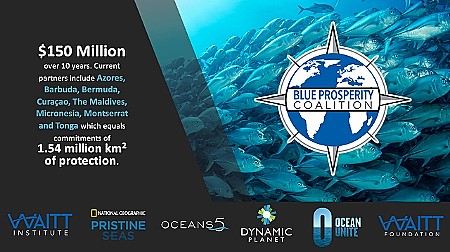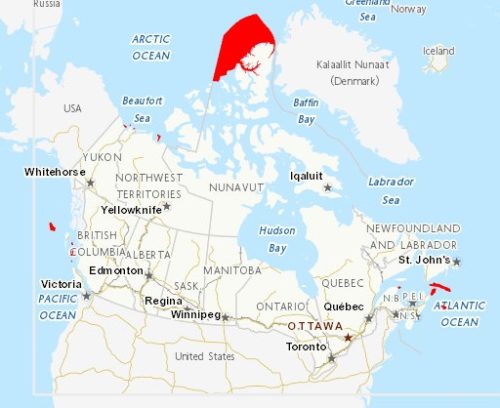October 26, 2019 – What’s it going to take to protect 30% of the world’s oceans from further damage?
A multi-year partnership of NGOs, foundations, not-for-profit organizations, and academic institutions have come together under the name Blue Prosperity Coalition to implement marine protection for the purpose of ocean resource sustainability, ecosystem health, and to create places in the ocean where human activities are strictly limited for fishing, and resource extraction including fossil fuels and seabed mining.
Why the need for Blue Prosperity?
The global ocean economy is valued at $24 trillion USD annually. More than one billion of us rely on food sourced from the seas of the world as our primary protein source. Yet an area between 4 and 7% of the world’s oceans today are protected from human exploitation versus 14.9% of land areas.
Why protect 30%?
Is this an arbitrary number? Not so states The United Nations who have established it as an attainable goal by 2030. It is not the final target which is 50% by 2050.
What is the methodology being employed to protect the ocean?
Called Marine Spatial Planning (MSP), it uses data collected by designated zones in the ocean and aggregates human activities from fishing and aquaculture, to tourism and recreation, scuba diving and snorkeling, offshore energy exploration and extraction, shipping and moorages. MSP has come of age in the last decade for ocean-use management and gained its inspiration from the development of the Great Barrier Reef Marine Park, the first Marine Protected Area (MPA). Today more than 60 countries are applying MSP to manage their ocean economies and help in developing MPAs.
What are Marine Protected Areas?
In my country, Canada, a growing network of MPAs is being established to conserve and protect marine species and populations, archaeological sites, shipwrecks, and areas traditionally associated with First Nation and other communities connected to the oceans. On the map below, the areas appearing in red are the current MPAs. When you consider the entire coastline of the country, it doesn’t seem like much as of yet has been saved by the Canadian government from human exploitation. In the recent election, however, the returning Liberal government made a pledge to protect 30% of the country’s land and oceans by 2030.
Zoning the ocean for the purposes of protecting marine resources and biodiversity is a concept that has been around for some time. It is comparatively easy to set up MRAs along coastlines, but the mid-oceans of the planet are equally at risk and represent the last frontier on our planet. Unfortunately, The United Nations has failed to develop a uniform global strategy when it comes to the oceans, unlike its success in getting nations to agree on setting carbon emission reduction targets.
What is the Process to Implement MSP?
MSP, if done properly, produces a comprehensive ocean plan including financing, monitoring, evaluation, and adaptation of marine environments with a focus on sustainability. In implementing MSP the goal is to avoid exceeding the capacity of a marine ecosystem leading to overfishing, habitat degradation, and increased pollution.
The initial step involves assessing the current and projecting future conditions including:
- Initial ecological and fisheries assessment with a synthesis of existing data
- Mapping the habitat and important ecological areas, existing and potential future human activities, including identifying spatial conflicts, compatibilities, and trade-offs
- Assessing the legal framework related to ocean management
- Consulting coastal communities and conducting surveys
- Evaluating financial requirements
- Developing compliance and enforcement requirements
In phase two, the actual MSP will be developed and approved by:
- Identifying spatial management scenarios
- Developing spatial zoning maps and a management plan
- Passing MSP legislation and regulations
- Soliciting stakeholder feedback throughout this phase of the process
In phase three, MSP implementation will include:
- Building and strengthening implementation capacity
- Demarcating protected areas and other zones as needed
- Supporting compliance and enforcement
- Developing monitoring protocols for habitat, fisheries, and socioeconomic assessments
- Supporting education and outreach
- Promoting ocean protection in international forums
Once in place the MSP will require:
- Continuous monitoring and evaluating MSP performance
- Adaptation and adjustment to the MSP as needed
Putting Money Behind MSPs
The Blue Prosperity Coalition on October 24, 2019, announced it had received $150 million USD over 10 years from the Waitt Foundation, a LaJolla, California-based not-for-profit organization focused on ocean conservation. The Foundation funds smaller conservation projects through its Rapid Ocean Conservation Grants Program. The Waitt Foundation donation is a good start, but the maritime nations of the world will need to poney up considerably more if the MSP strategy is to succeed.
















